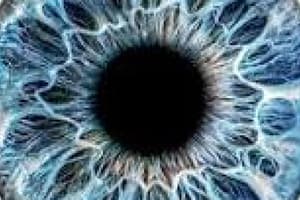Podcast
Questions and Answers
Which type of eye movement enables viewing the world under different circumstances?
Which type of eye movement enables viewing the world under different circumstances?
- Smooth pursuit
- Optokinetic
- Vestibular (correct)
- Saccades
Which type of eye movement involves the coordination of ocular muscles and orbital ligaments?
Which type of eye movement involves the coordination of ocular muscles and orbital ligaments?
- Vestibular
- Saccades
- Vergence (correct)
- Smooth pursuit
Which type of eye movement is described as involving fast, ballistic movements?
Which type of eye movement is described as involving fast, ballistic movements?
- Saccades (correct)
- Vestibular
- Smooth pursuit
- Optokinetic
Which type of eye movement involves tracking a moving object?
Which type of eye movement involves tracking a moving object?
Which type of eye movement is associated with the neural control of eye movements?
Which type of eye movement is associated with the neural control of eye movements?
What is the typical magnitude of saccadic eye movements?
What is the typical magnitude of saccadic eye movements?
Which system works to maintain a stable retinal image during head movements?
Which system works to maintain a stable retinal image during head movements?
What is the speed of most saccadic eye movements?
What is the speed of most saccadic eye movements?
How are eye movements recorded using the search coil method?
How are eye movements recorded using the search coil method?
What is the typical speed of smooth pursuit eye movements?
What is the typical speed of smooth pursuit eye movements?
Study Notes
Ocular Motor Function and Eye Movement Summary
- Ocular movement occurs around three axes: x for vertical eye movements, y for cyclorotational eye movements, and z for horizontal eye movements.
- The field of fixation is around 40-50°, with typical eye movements around 15° in magnitude.
- Saccadic eye movements are fast, leaping movements occurring at about 400-700 degrees/second, with most movements taking about 300 milliseconds.
- Saccadic eye movements are used in sampling the visual environment, such as in reading, driving, and perceiving threats.
- Smooth pursuit eye movements maintain stability of an object on the retina and typically do not exceed about 40° per second, observed by tracking a moving target.
- The vestibular and optokinetic systems work to maintain a stable retinal image during head movements, with different sensory signals generating compensatory eye movements.
- Methods to measure eye movements include direct observation, EOG, infra-red reflection, scleral search coil, Purkinje eye tracker, and video systems.
- The EOG records eye position using electrodes attached to the face, while the search coil method recorder measures eye movement using a coil embedded in a contact lens annulus.
- Infra-red reflection methods detect reflected infra-red light from the anterior eye by sensors mounted onto spectacle frames, proportional to the eye movement.
- The presentation encourages questions via Brightspace discussion board or the chat function on Teams.
Studying That Suits You
Use AI to generate personalized quizzes and flashcards to suit your learning preferences.
Related Documents
Description
Test your knowledge of ocular motor function and eye movement with this quiz. Explore topics such as saccadic and smooth pursuit eye movements, measurement methods, and the role of vestibular and optokinetic systems in maintaining stable retinal images.




